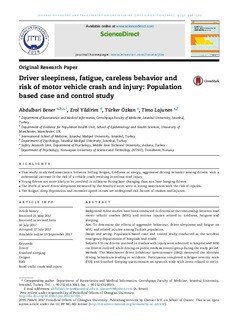| dc.description.abstract | Background
A few studies have been conducted to determine the relationship between road motor vehicle crashes (MVC) and serious injuries related to tiredness, fatigues and sleeping.
Aim
To determine the effects of aggressive behaviour, driver sleepiness and fatigue on MVC and related injuries among Turkish population.
Design and setting
Population-based case and control study conducted at the accident emergency departments of hospitals and roads.
Subjects
515 car drivers involved in crashes with injury were admitted to hospital and 1030 car drivers involved while driving on public roads as control group during the study period.
Methods
The Manchester driver behaviour questionnaire (DBQ) measured the aberrant driving behaviours leading to accidents. Participants completed a fatigue severity scale (FSS) and Stanford Sleeping questionnaire an epworth scale with items related to socio-demographic information, driving experiences, adherence to traffic laws (such as speed limits and seat belt), and drivers’ driving records.
Results
In a representative sampling, participant’s age ranged from 25 to 65 and the mean and standard deviation were 36.5 ± 7.8 for cases and 37.0 ± 8.0 for controls. There was a significant difference in both group of drivers regarding BMI, level of education, marital status, driving experience, seat belt use, excessive speed limits, physical activity number of sleeping hours, mobile phone use, and cigarette smoking habit (p = 0.017). Also, there was a significant higher mean score on all the DBQ violation questions among case group in comparison with the control group (p < 0.001). Further, cases had higher prevalence of Epworth sleeping disorders (p < 0.001) and fatigue severity (p = 0.003) compared to control drivers. Multivariate logistic regression revealed that excessive speed, fatigue, lapses, errors, Stanford sleepiness score, violations, mobile phone use and Epworth sleepiness scale were significantly associated with injury involvement in vehicle crash, after adjusting for driving experience and annual mileage.
Conclusion
The current study confirmed that drivers with chronic fatigue, acute sleepiness, and careless driver behavior may significantly increases the risk of road crash which can be lead to serious injury. | nb_NO |

